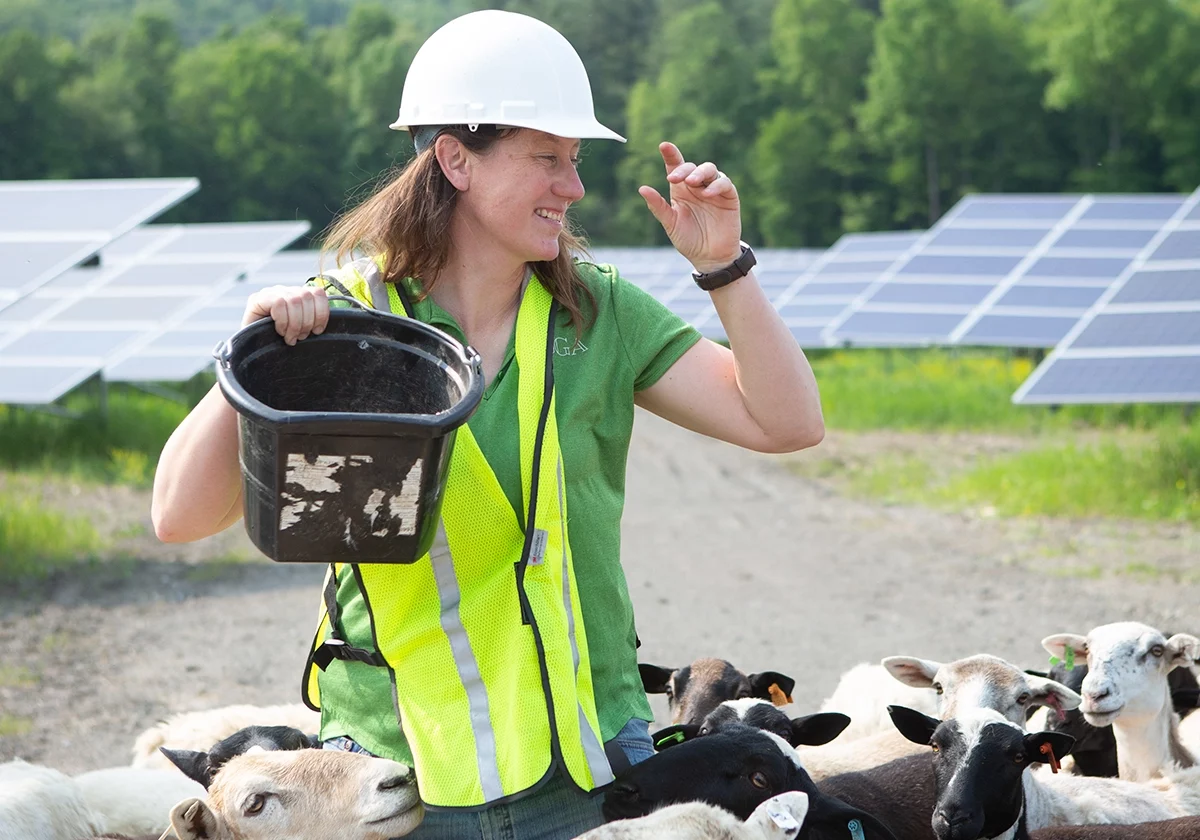NEW YORK STATE: Leading the flock
New York State is poised for an agrivoltaics revolution. But to get there, we’re going to need a lot of collaboration between agriculture and energy—and a lot more sheep.
The River, Hudson Valley Newsroom
9:00 AM EST on Jan 15, 2022

- This story has been supported by the Solutions Journalism Network, a nonprofit organization dedicated to rigorous and compelling reporting about responses to social problems. We are seeking reader feedback via a survey at the bottom of the article.
This is how it begins: A farmer and an agricultural economist walk into a bar.
Greater Ithaca being what it is, the bar is Brookton’s Market, a little country store with two dozen craft brews on tap in the tavern, proudly local eggs starring in the breakfast sandwiches, and a bounty of fresh foods from local farmers and producers. The perfect spot to hatch an agricultural revolution.
The year was 2019, and farmer Caleb Scott noticed Cornell professor Todd Schmit across the room. Scott decided it was a good time to sit him down for a beer and a chat about organizing sheep farmers into a co-op to work with solar developers.
“I knew he did work in this realm. I just pitched the idea to him. I said, ‘Look, this really needs to happen,’ and he’s like, ‘Let’s do it,’” Scott says.
Schmit now heads a three-year $500,000 project, funded by Cornell and the USDA, to dig into potential economic opportunities for a farmer-owned business cooperative focused on solar grazing. Scott is vice president of the American Solar Grazing Association (ASGA), a nonprofit devoted to supporting and professionalizing the fledgling solar grazing industry. Together with a small but growing crew of farm and renewable energy advocates, they are working to put sheep under solar panels across the Northeast as proof of the power of “agrivoltaics”: a growing field that combines renewable energy development with farm production, to the benefit of both industries as well as local communities and ecosystems.
“There’s very aggressive renewable energy goals by the state, of which they’re trying to do a lot with solar. And frankly, there aren’t enough sheep in the state to graze it all,” Schmit says. “This is a real opportunity for growth in a relatively small agricultural production sector in the state.”
The challenges ahead are steep, and so is the learning curve—for both farmers and energy developers. But the potential rewards of agrivoltaics go far beyond the bottom line. Advocates want to do more than just turn a bunch of sheep out to graze under solar panels. They have a much grander vision.
They want to make the New York farm thrive again.
Siting Solar: Beyond the Zero-Sum Game
New York’s 2019 climate law, the Climate Leadership and Community Protection Act, set an ambitious energy goal: a completely zero-emissions electrical grid by 2040. About half of New York’s electrical power currently comes from fossil gas plants, and most of the rest is split between hydropower and nuclear. Solar and wind make up just about 6 percent. To meet the goal, New York needs to build a lot of new energy projects, and fast.
That’s why state policymakers are working to speed the process of renewable energy siting. Meanwhile, the price of building solar power is falling steeply, making New York primed for a renewable-energy gold rush.
The ideal solar site is flat or with a gentle south-facing slope, on firm ground, cleared of tall vegetation, with good road access, close to transmission infrastructure, and not home to a sensitive natural ecosystem. For much of upstate New York, that means farmland, especially for siting the large utility-scale projects that are needed to make a real dent in the state’s greenhouse gas emissions goals.
“We’re looking at connecting facilities to some pretty large transmission lines that require a certain amount of scale to make projects economically viable, and in most cases, the only way we can do that is by siting on farmland,” says Kevin Campbell, senior development manager for EDF Renewables, a multinational energy company that is expanding its operations in New York.A new project backed by Cornell and the USDA will explore the economic benefits of grazing sheep under industrial-scale solar arrays.
As New York has picked up the pace on transitioning from fossil fuels to zero-carbon energy, the prospect of green farm fields sprouting solar panels has become controversial in many upstate communities. In rural Copake, where Hecate Energy is seeking to build a 60-megawatt utility-scale solar farm, much of it on existing farmland, a neighbor-against-neighbor battle over solar power has metastasized into a lawsuit against the state’s renewable energy siting board. Solar power opponents across the state worry about the loss of prime agricultural land, already under pressure from residential development, to energy production.
The promise of agrivoltaics is that land use for renewable energy isn’t a zero-sum game. One site can support both energy production and thriving agricultural use—and if existing monocultures of corn and soy are replaced by solar panels and sheep, dual use can create new habitat for wildlife like pollinators and grassland birds. Shepherds can use regenerative agriculture techniques and rotational grazing to improve soil health and sequester carbon, potentially improving the land for future farm operations.
“There is nothing more rewarding or beautiful to me than walking out and seeing a sea of beautiful blue solar panels with hundreds of sheep happily grazing underneath,” Scott says. When he’s describing a solar grazing site in full operation, his voice takes on an almost evangelical lilt. “The sheep love the cover and the wind protection that the panels provide. They’re out of the rain. They are thriving. Little lambs, bouncing all over. Wildflowers everywhere, because of the rotational grazing. I put honey hives up on these sites, and the bees flourish. We’re increasing pollinators. We’re getting honey off the land. It is really, really, really beautiful.”
It’s a grand vision for New York. But there’s a problem: There aren’t enough sheep.
Counting Sheep
A couple of centuries ago, there were more sheep than people in New York State. In the early 1800s, wool factories in the Northeast depended mostly on local supply, and with a high price for wool, farmers stepped up to meet the demand. According to L.G. Connor’s 1921 history of the American sheep industry, wool was so profitable in the 1830s that many farmers shifted from dairying to focus on wool-growing flocks. By 1837, Connor writes, there were about 18 million sheep in the US. A quarter of them were in New York, which at the time had a human population of about two million.
New York is now home to only about 79,000 sheep. To seize the renewable-energy moment, its flock will have to grow—and New York isn’t alone. “I was just talking with one developer, and he said to me, ‘There’s not enough sheep in the entire state of Georgia to just take care of our sites,’” Scott says.
The size of the average farm in the region is also an issue. The typical New York sheep farmer, Schmit says, is a hobbyist or a farmer focused on some other sort of production, with maybe 10 or 20 breeding ewes. A large solar site of several hundred acres might need 10 times that many sheep to keep vegetation in check. Until New York’s sheep operations can grow to meet the demand, small farmers will need to band together to negotiate.
“Developers don’t want to deal with 10 or 20 farms to get their whole sites grazed when they can talk with one entity that can represent those different farms,” Schmit says. A solar grazing co-op could also help the smallest farmers share equipment, or divide farm tasks between sites more efficiently.
From the developer’s point of view, having sheep graze a site isn’t a favor to the farmer—it’s a necessary service, with a legal contract in place. Solar grazing flips the economics of land access, turning what is typically an expense for farmers into a source of revenue. Solar arrays need mowing anyway: Without constant maintenance, typically done by hired landscapers with carbon-spewing lawnmowers and weedwhackers, solar arrays quickly become overgrown by vegetation that casts shade on the panels and makes the arrays difficult to access.

The sensibility of using low-tech sheep instead of high-carbon machines on a project designed to produce clean energy speaks for itself. But there are other advantages to using sheep instead of tractors, Scott says. An erstwhile landscaper himself, he worked on solar sites with machinery before getting into solar grazing.
“I was getting equipment stuck, it was just a disaster,” he says. “We were weedwhacking under the panels, which took 100 man-hours for 10 acres. It was insane. The contractors who did all the site restoration work left ruts everywhere. They left huge rocks that you hit with your mowers, tree stumps, you name it. I went, ‘You know, I’ve got sheep at home, they would do a lot better job.’”
Ewe-ge Opportunities
The economics of sheep raising in New York have done a hard reversal since their 1800s heyday. But the prospect of being paid by solar developers to graze their animals could utterly transform the economics of sheep farming, advocates say, turning it from a backyard side project to a viable enterprise.
“Sheep farming in the United States hasn’t really taken off because it hasn’t been a profitable venture,” Scott says. “But now, with the opportunity to provide a service through feeding your sheep, it’s increasingly making sheep farming maybe one of the most profitable animal husbandry markets that’s scalable.”
There is nothing more rewarding or beautiful than walking out and seeing a sea of beautiful blue solar panels with hundreds of sheep happily grazing underneath.
Caleb Scott
A resurgent sheep farming industry would open other opportunities for farmers, as well. Right now, more than half of the lamb consumed in the US comes from Australia and New Zealand, and most US lamb comes from larger farms west of the Mississippi. Flying meat thousands of miles carries a high carbon cost, as well as a missed opportunity for local farmers. It’s not for lack of local demand: According to the USDA, “the Northeast, with its high concentrations of Middle Eastern, Caribbean, and African consumers, is a major market for lamb products.”
One barrier to sheep farming in New York is a dire shortage of local meat processing facilities. If locally raised lamb is ever to make a real comeback in the Northeast, that’s a problem that will need to be solved—possibly with help from a co-op, Schmit says, which could help give small farmers the economy of scale they need to compete for processor time.
But equally pressing is the issue of land. Without access to prime farmland, which usually can only be had via a family inheritance or a paid lease, many farmers struggle to break into the industry or to grow a hobby into a viable business. It’s an acute issue for younger and first-generation farmers, and for immigrants who may have honed the skills to run a farm operation but lack startup capital.
EDF Renewables already has a successful project that’s helped a young farm couple get established, on a 200-acre site near Ottawa, Canada. Farmers Chris Moore and Lyndsey Smith have kept a flock of several hundred ewes and their lambs on the site since 2017, and solar grazing has given them a vital income stream while enabling them to grow their flock.
“They bring their ewes in the spring on the site, they lamb on the site. There’s baby lambs all over the place come May, June, July,” Campbell says. “It’s worked great for us, it works great for them, and we would just love to bring that success into New York State.”
Looking Toward the Future
Agrivoltaics is still in its infancy. Practitioners around the country are developing different models for collaboration between farmers and energy developers, and it remains to be seen whether one will emerge that makes the most sense.
Some solar developers have begun hiring shepherds as salaried employees to manage in-house flocks, says ASGA’s executive director and cofounder Lexie Hain, a sheep farmer who grazes a 40-acre solar site in the Finger Lakes town of Newfield. In other places, environmental restoration companies are getting into the livestock business—like Minnesota Native Landscapes, a firm that specializes in ecological site management and offers grazing services and pollinator habitat plans to solar firms.
Hain sees ASGA’s role as helping the emerging field professionalize and develop expertise. The organization helps get resources to farmers looking to get into solar grazing—like a standard vegetation management contract geared toward grazers, and a “Fuzz and Buzz” pollinator-friendly seed mix developed in collaboration with a Pennsylvania seed company.
“We’re the ones looking at this from sort of a bird’s-eye view, this macro level,” Hain says. “ASGA’s focus is very much outreach, building out this industry and professionalizing it—when people want to get into it, to try to help them figure out, what are the steps? What are the tools?”

Judy Anderson, principal of the Kinderhook-based conservation consulting practice Community Consultants and former executive director of the Columbia Land Conservancy, is concerned that in the rush to get renewables built and jump-start the agrivoltaics industry, developers and farmers might miss opportunities to develop other forms of solar grazing and dual use. The typical design of a ground-mounted solar array is friendlier to sheep than to most other livestock, but there are ways to design arrays with elevated panels that allow for larger animals like cows and horses. Sites can be designed to allow tractors to operate between the panels, making different kinds of cover crops possible. These types of choices could have a major impact on agrivoltaics practices in New York for decades—and, by extension, the future of New York agriculture.
“We can’t simply rely on sheep. We need to diversify the market and diversify farming, because we’re making a commitment for the next 25, 30, 50 years with these installations,” Anderson says. “How are we designing them to allow for agricultural flexibility?”
Developers with an interest in agrivoltaics are also looking into ways to help more farmers get on board. In the Finger Lakes village of Mount Morris, where EDF Renewables is building a large solar-plus-storage project, the company has partnered with ASGA and local economic development group Letchworth Gateway Villages to study opportunities for marketing local lamb and honey. EDF is also exploring ways to work with Schmit on the Cornell co-op study, and investigating other forms of dual use on solar sites, like growing lavender, or pasturing rabbits and chickens.
“We can share that information with our communities across the state, because a lot of this is replicable,” says Haylee Ferington, community relations manager at EDF. “It’s about broadening that conversation. I don’t think developers have all the answers, but I don’t think farmers do either. We have to get as many people as we can in the room to think about this.”
Back to the Land
For everyone in the world of agrivoltaics, there’s growing recognition of the need to collaborate, plan ahead, and develop more expertise and best practices. Adapting one kind of business to the needs of another presents challenges, but it’s not often that two industries in their infancy have the chance to develop symbiotically. Sustainable long-term growth will depend on getting it right early on.
For farmers like Scott, growth feels like restoration. Like a lot of New York livestock farmers, Scott is familiar with the intergenerational grief of farm loss that reverberates beyond the balance sheet. The seventh-generation scion of dairy farmers, Scott had a ringside seat to the collapse of his family’s farm in the 80s. In agrivoltaics, he sees hope for New York farmers to regain what was lost.
“That was pretty traumatic to lose your family’s land, to lose your animals because the price of milk tanked,” Scott says. “I was just a little kid at the time, but you still remember that stuff. Now, here’s an opportunity for me to grow in an industry. I really believe that this is going to fundamentally change a lot of farmers’ lives.”
https://therivernewsroom.com/new-york-agrivoltaics-leading-the-flock/


